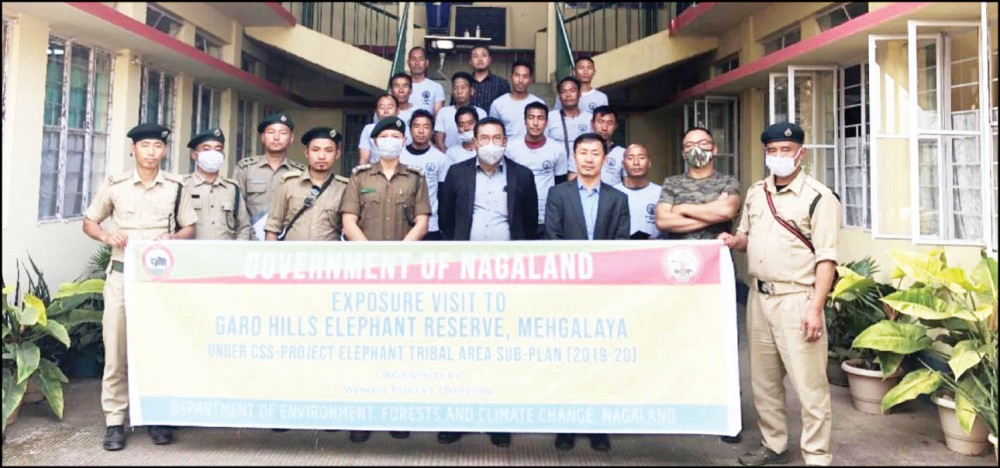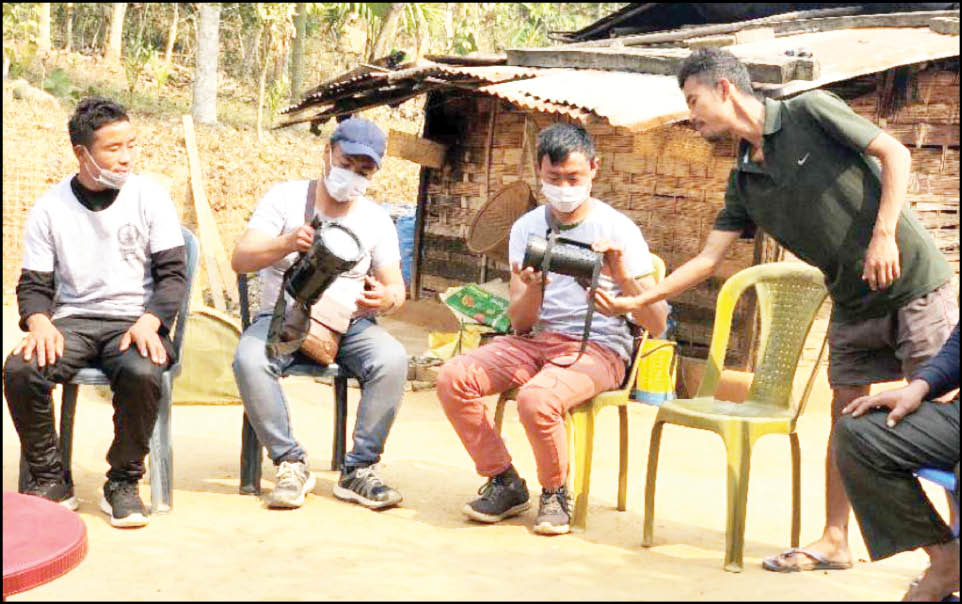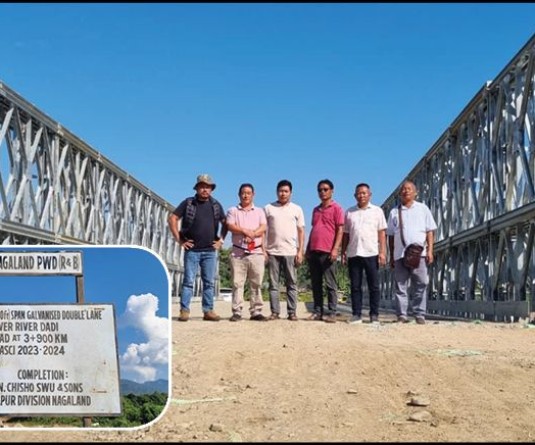Nagaland exposure team along with S N Sangma, IFS, CF Wildlife and Arpiyush Sangma, DFO Wildlife, Meghalaya Forest Department.

Wokha Forest Div organises exposure trip to Garo Hills Elephant Reserve
Dimapur, February 27 (MExN): For many years now, villages in Nagaland, particularly those around Wokha district have been dealing with Human-Elephant conflict which are complex and complicated with no single solution.
In order to equip farmers and villagers with new techniques and methods for managing this situation, an exposure trip to Garo Hills Elephant Reserve, Tura, Meghalaya was organised by Wokha Forest Division for the farmers of Wokha district.
As per the 2017 synchronised nation-wide elephant census, Nagaland is home to over 400 Asiatic Elephants. Out of this, Wokha district alone accounts for over 70% of total elephant population.

Nagaland Anti-Depredation Squad members shown equipment used by farmers for man-elephant conflict mitigation in Meghalaya.
“As such, human-elephant interactions in the district are very frequent, often resulting in extensive property and crop damage, and at times loss of life to both humans and elephants,” stated in a press release.
Despite best management practices already implemented in the villages, it is imperative to continue looking for newer and improvised ideas to better handle and mitigate the situation. Hence, the need to visit areas facing similar situation in order to explore for newer and additional mitigation measures is crucial.
The exposure trip to Garo Hills Elephant Reserve was undertaken by the Forest Department of Nagaland with an aim to learn from others, while also exchanging our successfully tried-and-tested conflict mitigation measures with them, the release added.
A team of 18 members underwent the five-day tour from February 9 to 13. It included 12 farmers from 12 villages namely Tsingiki, Nungying, Old Riphyim, New Riphyim, Old Changsu, Akuk, Morakjo, Okotso, Chudi, Sanis, Lakhuti, and Meshangphen.
The tour was led by Lansothung Lotha, Range Forest Officer, Baghty Range and assisted by Zaremo Kithan, Forester-I, Johnny from Wildlife Wing, Dimapur and Hosia Kikon, W Thungchamo Kikon and Pilamo K Ngullie from Wokha Forest Division.
This tour was organised under ‘Project Elephant’ and the farmers were also part of the highly effective and efficient Anti-Depredation Squad formed under the same project.
The Garo Hills Elephant Reserve, Tura is unique in the sense that it comprises of three districts viz. South Garo Hills, West Garo Hills and East Garo Hills, amounting to a total area of 3500 sq km.
About 85% of this large reserve falls under community owned lands. This extensive reserve is managed by the East and West Garo Hills Wildlife Division, and Malpakram National Park.
For many years now though, the communities in and around the reserve have been continuously working with the Forest Department towards management of the conflict situations.
In many cases, the communities are also rendering voluntary service in the form of Anti-Poaching Squad to help mitigate the costly and at times deadly interactions between man and elephants.
A meeting with the officials of Wildlife Division, Meghalaya Forest Department was held on February 10 at the Forest Office Complex, Tura. SN Sangma, IFS, Conservator of Forests (CF), Wildlife, and Arpiyush Sangma, Divisional Forest Officer (DFO) Wildlife, interacted with the team from Nagaland and were briefed about various aspects with a focus on the functioning of the reserve and management of conflict situations.
The team from Nagaland during the field visit to fringe area of Nokrek National Park with Wildlife Trust of India (WTI) were informed about the various interventions introduced by WTI, especially with regard to crop depredation caused by wild elephants through various programs.
One such effort is the grain-for-grain programme where relief is provided in the form of rice grains to farmers who have lost their crops to damage by elephants.
WTI also works closely among communities and provide technical assistance to the Wildlife Wing, Meghalaya Forest Department whenever required. Balsreng Sangma from WTI was the resource person.
The team visited Genapara village near the Indo-Bangladesh border. The farmers from Nagaland had the opportunity to interact with the farmers of Genapara village who face man-elephant interactions frequently.
The wild elephant population in this area is unique in the sense that they roam between Indian and Bangladesh through marked corridors along the international border. Some new techniques seen were the use of Galvanized Iron pipes (2-3 ft in length) to scare elephants away. Crackers are inserted into the pipe which then creates gunshot-like noise to scare the elephants. Other methods included the use of drums to create noise, use of fire torch technique, spot-lights, etc.
Farmers in the area also have strong taboo against any harm caused to wild elephants and hence, have a very tolerant perspective toward the elephants even in times of damage. Also, the farmers in the area provided voluntary service to the Forest Department in the form of Anti-poaching Squads.
The team from Nagaland was granted special permission to visit the otherwise restricted Indo-Bangladesh international border. There, the team was shown the multiple Wildlife Corridors all along the international fence whereby wild animals, specifically elephants could move between the two countries through their ancient corridors.
Later, the team visited Sakal Aduma, a tourist spot near Tura and on the fringe area of Nokrek National Park & Biodiversity Hotspot.
On completion of the tour, the team also visited some famous and well-known places in Meghalaya. This included places such as Arwah Cave, Nohkalikai Falls, besides and Cherrapunjiitself and Shillong.






